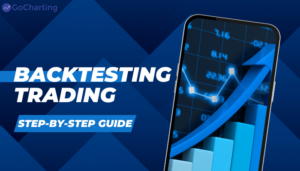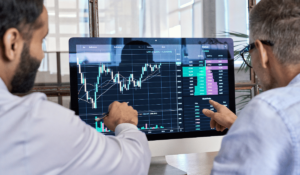
Backtesting trading is an effective strategy or a method to determine the market’s previous performance based on how well or negative the market had performed in the past. Every trader whether they are new or an experienced trader they always use the strategy called backtesting.
If backtesting performed well, then it could potentially minimize the probability of losses. In this post we’re going to share a step-by-step guide for backtesting. You just need to read this article completely and thoroughly
What is a Backtesting Trading Strategy?
Backtesting is the practice of evaluating the potential performance of an analytical approach or trading strategy using previous data. It is essential to creating a successful trading strategy.
There are countless possible techniques, and even the slightest modification will have an impact on the outcomes. Backtesting trading strategy is crucial since it reveals whether some parameters will perform better than others, which is why.
A trading strategy is necessary for backtesting. A trading strategy at the very least aids in defining the entry and exit points for both profitable and unsuccessful transactions, as well as a position size. A trading strategy additionally will frequently include context, such as outlining when and if trades should be made.
Steps For Backtesting Trading Strategy

Your trading strategy should be clearly defined in terms of entry and exit criteria, indicators, timeframes, as well as any other relevant elements. This stage lays the foundation for your backtesting process.
Accurately bring together historical market data for the chosen time frame. This includes data on prices, volume, as well as additional important factors. Always ensure that it is exactly exhaustive, while accurately depicting the circumstances of the market throughout the chosen period.
Utilize the historical facts to put your stated strategy into action. To automate the process, use a backtesting trading software tool, or manually simulate trades by adhering to the particular strategy’s rules. Keep note of your stop-loss as well as take-profit levels as well as trade entry and exit spots.
Measure and log the outcomes of each simulated trade in the performance evaluation. Calculate data points such as profit and loss, win-loss ratio, risk-reward ratio, maximum drawdown, as well as annualized return. You can better comprehend the strategy’s past performance thanks to this analysis.
Investigate trends, advantages, and disadvantages in the performance measurements and data that have been gathered together. Depending on the new information, change the strategy’s parameters, indications, or regulations. To evaluate how changes in parameters impact outcomes, perform a sensitivity analysis.
Backtesting Trading Strategy Using a Software Tool
In order to analyze and develop the success of a trading technique using past market data, backtesting entails employing software such as GoCharting. The application asks traders to enter their strategy’s guidelines, constraints, as well as indicators before comparing their results with previous market circumstances.
Trading professionals may implement this strategy to determine a trading strategy’s potential profitability as well as risk under different market circumstances.
By analyzing how the strategy they are using would’ve performed in previous times, GoCharting’s backtesting work empowers traders to make choices that are right. This function additionally allows traders to improve as well as optimize the trading technique to improve its usage in the future.
Key Factors to Consider
Backtesting requires careful consideration of a number of important aspects. Reliable historical data guarantees accurate findings, therefore data quality is crucial. Transaction fees, slippage, and market circumstances must all be taken into consideration for realistic trading scenarios to occur.
Avoid overfitting by not excessively optimizing the strategies you employ based on historical data, since this might result in poor outcomes in real-world markets. Stress-test strategies using different scenarios mainly because market circumstances could possibly change.
Last but not least, successful risk management, including position size as well as stop-loss levels, must be performed for helping to protect money as well as manage possible losses during both backtesting and live trading.
Difference Between Backtesting and Paper Trading
Paper trading and backtesting trading are both essential tools for traders, but they have different functions. In order to determine a trading strategy’s prospective performance, backtesting includes testing it using past data. Evaluating the previous profitability of the strategy enables traders to improve as well as optimize it. However, it doesn’t take into consideration real-time execution difficulties like slippage or market dynamics.
Paper trading, on the other hand, simulates deals in real-time settings without risking any real money. It gives traders another opportunity to test their methods, improve their trade execution abilities, plus detect reactions that are emotional. Paper trading, as opposed to backtesting, takes slippage as well as order execution into account in real time. The emotional effect of actual trading is absent, therefore it might not accurately reflect market reality.
Why is Backtesting Important?
For the purpose to evaluate as well as enhance trading methods, backtesting trading offers a systematic methodology. It gives traders the ability to evaluate how a strategy might have fared in previous market circumstances, helping them in determining strengths and also shortcomings.
Backtesting allows traders to better understand their tactics, establish reasonable goals, as well as boost their level of confidence. It additionally provides assistance with risk management by determining probable drawdowns as well as evaluating risk-to-reward ratios.
In the end, backtesting provides traders with the understanding necessary in order to make wise choices, deepens the understanding of market dynamics, and raises the possibility that techniques are likely to prove successful when implemented in actual trading situations.
Final Words
Although there is no special test that can forecast future performance. Since it enables traders to test their methods before putting them into practice on the market, backtesting works well in the trading system. But if done with prejudice, it can fool the trader.
Even when done correctly, employing a backtest alone could not produce useful findings. To evaluate the feasibility of the techniques, backtest is, therefore, better employed in conjunction with other metrics.